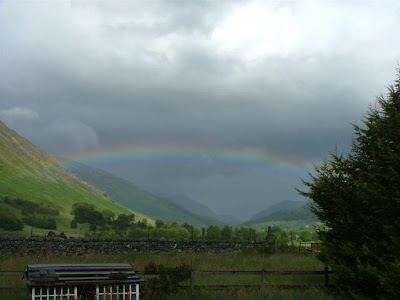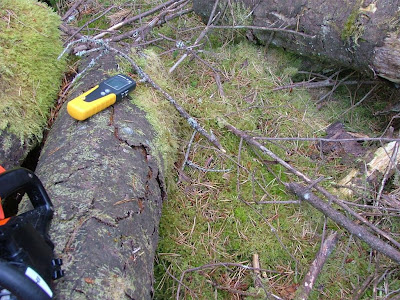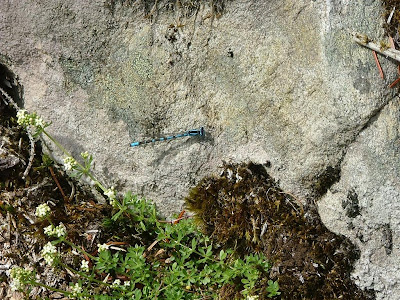I have recently written a report for the Forestry Commission on Ring-barking as a drying method. This report was written to accompany a felling licence application to carry out a first thin in a stand of larch trees using ring-barking as the thinning method. Drying wood chips to a low moisture content (MC) sustainably is a big challenge and I believe that ring barking (removing a strip of bark from around the tree, followed (unfortunately) by a chemical injection) is a potentially very effective, low input method of naturally drying timber. Parts of the report follow below. Intrigued? Please carry on reading,.. feeling a bit bored already- that was probably the interesting bit above.
In Scotland's occasionally damp climate....
In Scotland
They also require the processor to have a substantial amount of space for housing the infrastructure and the sheds
Our situation as a community group with no property available to us does not currently let us contemplate a forced drying process, even if we wanted to.
We have therefore directed significant research towards natural drying methods and have come to the conclusion that, of the three methods assessed (drying in stacks and piles, ring-barking and sour felling), ring-barking or girdling the trees could offer most benefits, both in terms of low impact, low cost thinning and also in terms of a reduced MC product being produced.
Ring-barking
For a community group such as ours, which may need to build up a sustainable, low cost, low impact supply of dry or drying firewood for primarily local use, thinning by ring-barking may well be the optimum method to employ.
Using chainsaw, axe or scorp and chemical injection an individual or a small workforce could carry out an inexpensive very swift, selective thin, without it being apparent that they had done so until some inevitable browning appeared in the canopy. The canopy meanwhile remains intact (in a similar way to that of a self thinning mixture) until the tree is removed from it a year or two later by which time competition for light will have led neighbouring trees to begin to close the gaps left by the trees demise. The use of a thinning method that does not leave a network of holes in the canopy could be assumed to be an advantage in unthinned plantations at potential risk of windthrow.
It would also appear from our research that an optimum drying point can be reached where a stump attached sawlog still retains a high MC while the top third of the tree has reached an MC of 30% or below. In essence the top most easily processed third of the tree is ready for burning while the potentially economic bottom half or two thirds is still saleable or capable of being milled.
Ring-barking is an unconventional practice in the UK
Sour Felling.
Sour felling involves felling trees and leaving them intact (whole tree) on the forest floor or in stacks at roadside. Significant research has been carried out on sour felling as a drying method, principally in the UK Canada
Sour felling research experiments have reached the following conclusions:
1. Leaving limbs and foliage on felled trees significantly increases moisture loss through transpiration compared to removing the limbs.
2. This enhanced drying effect lasts for a limited period of time, typically between 6-18 months. Some Swedish studies report an optimum transpirational drying period of between 4 and 6 weeks.
3. During the drying period foliage (needles or leaves) will drop from the limbs. If whole tree chipping for woodfuel is being considered, the loss of this foliage increases the calorific content of the fuel and reduces the ash content. Leaving the foliage on the forest floor returns a proportionate amount of nutrients to the forest cycle.
4. The effectiveness of sour felling as a drying method is dependent both on the seasonal timing of the felling and the density of the remaining canopy.
5. Sour felled logs will be lighter to remove from the forest, but MC’s will be variable throughout the crop. The research carried out into sour felling proves that an enhanced drying effect will be experienced if foliage remains on the tree following its demise.
The benefits of sour felling as concerns transpiration will not only also apply to ring-barked trees but could be expected to be somewhat enhanced given that conditions in the upper canopy are somewhat more exposed to the drying effects of the elements than on the more enclosed and humid forest floor. Conversely it is unlikely that the tree as a whole will benefit from the reduced weight of sour felled trees, as moisture (trapped by bark) will drain down the cambium layer. This is in accordance with general folk wisdom concerning standing deadwood that the tops will be very dry but at chest height the log will contain high levels of moisture.
Sour felling
Sour felling, as a drying method in Glenlyon appears to have numerous disadvantages compared to ring-barking.
A negative visual appearance is very much a disadvantage of sour felling. Looking somewhat similar to partially tidied windblow, sour felling would be an unlikely choice for a roadside thin in an area known for its sylvan beauty.
A potential knock on expense
From the point of view of the estates who own these forests having their forest edges slowly turned into something that both looks like, and presents, similar access problems to windblow could well be an unattractive option, both from a visual perspective and also from a “What happens if GWI folds and the estate needs to tidy up” point of view.
Sour felled Pine thinning in Glenlyon. The edges were thinned less heavily than the middle but are still pretty impenetrable as concerns access. Sour felling was only appropriate as the site was remote.
An increased fire risk could be an unwanted result of sour felling. Felled and delimbed normally much more of this visible (very dry) branching would be damply decaying in the grasses and bracken, that by now would be present as an under storey but are currently being shaded out by the brash. Having such “tinder” line the glen road may not be wise in terms of fire prevention.
The expense of, and need for, multiple operations makes Sour felling an expensive and complicated way to obtain a low value product ; Much of the unthinned woodland in Glenlyon is Sitka spruce, planted at a 2 metre spacing. The crowns of these trees are often locked together or entwined with those of their neighbours which can result in great difficulty in actually getting the tree down during selective thinning operations. Put simply – you fell them and nothing happens, they do not fall down or even necessarily move in the canopy. To economically bring down these trees for sour felling would involve both chainsaw work and a winch assisted takedown. To have such infrastructure in the forest and to then “half do the job” i.e. to then exit the wood, without brashing or extracting to roadside, only to return a year or so later to reintroduce the equipment and finish the job (brash- extract to roadside) has obvious disadvantages for a small roadside operation such as ours.
Inconsistency in the drying effect makes forward planning awkward. I have been involved in various sour felling operations in Glenlyon. Revisiting these and measuring moisture contents revealed inconstancies in drying rates both in and across species. The pine in the photos, felled around 2005 was still reading, on average a fairly high 35% along its length. Some nearby Sitka sour felled at the same time was down to around 20% and one wind snapped Sitka spruce, down less than 2 years was 11-13% along its top third and around 19% in the middle and lower end.
The majority of the sour felled trees assessed by the author for this report showed heavy signs of predation by deer, with extensive defoliation presumably having happened early in the drying stages quite possibly during the first winter that the tops were on the ground. Such predation will obviously reduce the transpiratory benefits of leaving the canopy on. Deer are present in much of the woodland in Glenlyon and appear capable of moving through sour felled areas with relative ease.
Natural Drying Methods, Conclusion;
Of all the natural drying methods assessed it would appear that the transpiratory drying processes (sour –felling and ringbarking) were of most value in reducing moisture content without incurring particular expense. Of these two methods, ringbarking potentially requires least handling and labour input, making it probably the most economical method.
Although much of the information on ringbarking is based on conjecture and folklore, there is no reason for it to be inaccurate and although there is a small possibility of deadwood related hazard, this would be little different to that of a self thinning mixture, in which dead crowns are enveloped by their light hungry neighbours.
The conservation benefits of ringbarking as a thinning method could be very high. Not only would it increase the percentage of standing dead wood, but an interesting light mosaic would appear on the forest floor, mimicking a natural cycle where a tree dies, but the dead canopy persists, then over time the tree falls and what little area of the canopy persisted is open to light, before the canopy eventually closes again.
Sour Felling as a drying technique is not visually attractive and creates a hazardous walking surface. Its benefits in dedicated forest production areas, rich in machinery and labour and low in visitor interest could be very high should the end market require a moisture reduced (probably sap stain free) product.
The main practical disadvantage with sour felling is the need for machine assisted double handling, particularly when the stems are bunched together to dry. The main overall disadvantage with Sour Felling as a drying method for use in Glenlyon along roadsides and other amenity areas would be its negative physical appearance.
Drying logs in stacks is space efficient, but gives inconclusive results depending on stack location and the amount of effort expended in building it. Drying split firewood in stacks is a very good way to further reduce moisture content, particularly if the stacks are covered.
Weather conditions can greatly influence natural drying methods. It seems likely that ringbarked trees, exposed to winds running through the forest and standing away from the potentially humid forest floor will gain most from the drying effects of the elements. The transpirational benefits of seasonal ringbarking which involve the tree “flushing” in the spring are likely to advance drying further, also winter is increasingly a drier period overall than summer which, if humid, will slow down transpiration.
My conclusion is that ringbarking could offer a space efficient, low input and low cost, relatively sustainable method of naturally drying timber. For our community needs and situation it appears a potentially very useful tool for providing an economical source of low moisture content fuelwood.














 J
J
 R
R
 S
S
 I
I


 T
T

 T
T
